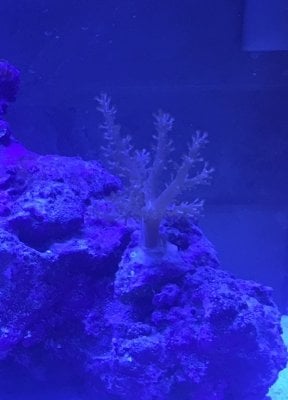melypr1985
totally addicted
View BadgesExcellence Award
Expert Contributor
Article Contributor
Moderator Emeritus
Beginner Corals- Leathers
All photos by: Melypr1985
Leather corals encompass a wide range of species. While there are many different types with different sizes, shapes, growth patterns and rates and even colors, they all have similarities. They are easy to care for, grow quickly, enjoy lower light and are beautiful especially when they get larger. It is an exceptional choice for the beginner who hasn’t learned enough about water chemistry or tank maintenance to be comfortable keeping more difficult corals like LPS (Large Polyp Stony) and SPS (Small Polyp Stony). They are also a great option for those that want corals but also a heavy fish load.
Leathers are soft corals, so named for their lack of hard skeleton made of calcium carbonate. They are often leathery or grainy in feel and appearance which is where they get the slang name of “leathers”. They do, however, have tiny skeletal bits called sclerites within their tissues. They can focus these sclerites into the base of their structure firmly attaching them to the rocks. This element also gives them the leathery look and feel we spoke of and the added benefit of making them a little less appealing to predators. Most of the corals in this category are photosynthetic and rely on nutrient rich water along with light to produce energy. These corals don’t need to be fed directly like you would an LPS coral that has a mouth and feeder tentacles. They will feed off of Phyto plankton in the water or other very small particle foods suspended in the water. You will find the colors are more subdued than you might find in SPS or LPS corals, but there is quite a bit of beauty there. Creams, whites, soft blues and purples, green and neon green, even yellow!
These corals can be grown fairly quickly compared to most LPS corals and they don’t get real picky about water quality. Lighting can vary as well, from the old compact fluorescent bulbs, T5HO, metal halides and LEDs, they can adjust to most light intensities. Most of the tanks I care for have been upgraded to LED but there are different spectrums and intensity with each tank. I have leathers in each tank at different levels and all have done very well. The leathers in the tanks with higher light had to be acclimated to that light over time, though it was done within a week or two and I had no ill effects from it. Flow is another requirement for leathers. Most people will tell you they need low flow, but I’ve noticed that they do much better in a higher flow environment. While they will do ok in a low flow tank, it’s better to be able to (at a minimum) adjust the flow a bit higher on occasion or to be able to move the leather to that higher flow area when needed. The main reason for this is as the coral grows it will become waxy looking buildup. The coral uses this as a defense mechanism and helps it keep from being overgrown by other surrounding corals. Knowing that, it can be useful to us as well. Seeing it several times a year is normal, but seeing it for a long period is not. If the waxy appearance doesn’t get blown away by the current, infection can set in and cause the coral harm. It can also show that the coral is stressed either by a new tank or a neighboring coral.
Fragging leathers can be very simple and straightforward. A sharp blade and a steady hand are often all that are needed. For the most part, just cutting off a bit of the coral at the edges will be sufficient to start a new coral. Toadstools, cabbage and crown leathers are like this. You can cut a piece off the edge, or a wedge shaped piece, rubber band it loosely to a rock or frag plug and in a couple weeks you’ll have a new coral growing for you. Finger leathers are just as easy. Take a firm hold of a “finger” or stalk of the coral and cut close the main, center stalk. You’ll want to use a sharp blade and clean strokes for cutting. These corals are easy to frag but they aren’t indestructible. I have a toadstool in the display at the shop that was severely injured during the “remodel” of that tank. The stalk and head of the toadstool was roughly sheared off and subsequently died. The bit of the stalk, or “foot” that was still attached to the rocks grew back a whole new toadstool in about 6 months.
This is the exact toadstool that I speak about that died and regrew.
Leathers are one of the best starter corals around. Some of them can grow quickly enough to be considered invasive (the Kenya tree comes to mind here), but most are moderate growers, easily fragged, and won’t break the bank to purchase or care for. Some people even keep leathers in angel tanks or predator tanks because, yeah.. the angels may take a bite every now and then but they grow quickly enough to recover well and they can handle the dirty water that preds can cause. What leathers do you keep in your tank? What do you love about them?
Discuss This Article Here





















